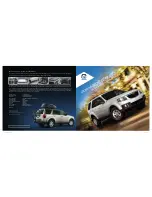
test surfaces of asphalt and concrete. A tire
marked C may have poor traction performance.
The traction grade assigned to this tire is
based on straight-ahead braking traction tests,
and does not include acceleration, cornering,
hydroplaning, or peak traction characteristics.
Temperature
The temperature grades are A, the highest, B,
and C, representing the tire's resistance to the
generation of heat and its ability to dissipate
heat when tested under controlled conditions
on a specified indoor laboratory test wheel.
Sustained high temperature can cause the ma‐
terial of the tire to degenerate and reduce tire
life, and excessive temperature can lead to
sudden tire failure. The grade C corresponds
to a level of performance which all passenger
car tires must meet under the Federal Motor
Vehicle Safety Standard No. 109. Grades Band
A represent higher levels of performance on
the laboratory test wheel than the minimum re‐
quired by law.
Temperature grade for this tire
The temperature grade for this tire is es‐
tablished for a tire that is properly inflated and
not overloaded. Excessive speed, underinfla‐
tion, or excessive loading, either separately or
in combination, can cause heat buildup and
possible tire failure.
If necessary, have the vehicle towed.◀
M+S
Winter and all-season tires with better cold
weather performance than summer tires.
Tire tread
Summer tires
Do not drive with a tire tread depth of less than
0.12 in/3 mm.
There is an increased danger of hydroplaning if
the tread depth is less than 0.12 in/3 mm.
Winter tires
Do not drive with a tire tread depth of less than
0.16 in/4 mm.
Below a tread depth of 0.16 in/4 mm, tires are
less suitable for winter operation.
Minimum tread depth
Wear indicators are distributed around the
tire's circumference and have the legally re‐
quired minimum height of 0.063 in/1.6 mm.
They are marked on the side of the tire with
TWI, Tread Wear Indicator.
Tire damage
General information
Inspect your tires often for damage, foreign
objects lodged in the tread, and tread wear.
Notes
Driving over rough or damaged road surfaces,
as well as debris, curbs and other obstacles
can cause serious damage to wheels, tires and
suspension parts. This is more likely to occur
with low-profile tires, which provide less cush‐
ioning between the wheel and the road. Be
careful to avoid road hazards and reduce your
speed, especially if your vehicle is equipped
with low-profile tires.
Indications of tire damage or other vehicle de‐
fects:
▷
Unusual vibrations during driving.
Seite 170
Mobility
Wheels and tires
170
Online Edition for Part no. 01 40 2 910 746 - VI/13
Online Edition for Part no. 01 40 2 926 037 - XI/13
Содержание M6 -
Страница 2: ...Online Edition for Part no 01 40 2 926 037 XI 13...
Страница 14: ...Online Edition for Part no 01 40 2 910 746 VI 13 Online Edition for Part no 01 40 2 926 037 XI 13...
Страница 32: ...Online Edition for Part no 01 40 2 910 746 VI 13 Online Edition for Part no 01 40 2 926 037 XI 13...
Страница 154: ...Online Edition for Part no 01 40 2 910 746 VI 13 Online Edition for Part no 01 40 2 926 037 XI 13...
Страница 166: ...Online Edition for Part no 01 40 2 910 746 VI 13 Online Edition for Part no 01 40 2 926 037 XI 13...
Страница 205: ...Care Mobility 201 Online Edition for Part no 01 40 2 910 746 VI 13 Online Edition for Part no 01 40 2 926 037 XI 13...
Страница 206: ...Online Edition for Part no 01 40 2 910 746 VI 13 Online Edition for Part no 01 40 2 926 037 XI 13...
Страница 221: ...Online Edition for Part no 01 40 2 926 037 XI 13...
















































